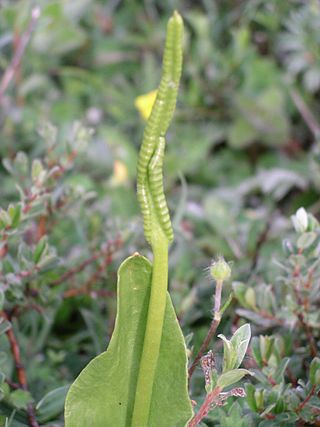
Ploidy is the number of complete sets of chromosomes in a cell, and hence the number of possible alleles for autosomal and pseudoautosomal genes. Here sets of chromosomes refers to the number of maternal and paternal chromosome copies, respectively, in each homologous chromosome pair—the form in which chromosomes naturally exist. Somatic cells, tissues, and individual organisms can be described according to the number of sets of chromosomes present : monoploid, diploid, triploid, tetraploid, pentaploid, hexaploid, heptaploid or septaploid, etc. The generic term polyploid is often used to describe cells with three or more sets of chromosomes.

Prospero Alpini was a Venetian physician and botanist. He travelled around Egypt and served as the fourth prefect in charge of the botanical garden of Padua. He wrote several botanical treatises which covered exotic plants of economic and medicinal value. His description of coffee and banana plants are considered the oldest in European literature. The ginger-family genus Alpinia was named in his honour by Carolus Linnaeus.

Polyploidy is a condition in which the cells of an organism have more than two paired sets of (homologous) chromosomes. Most species whose cells have nuclei (eukaryotes) are diploid, meaning they have two complete sets of chromosomes, one from each of two parents; each set contains the same number of chromosomes, and the chromosomes are joined in pairs of homologous chromosomes. However, some organisms are polyploid. Polyploidy is especially common in plants. Most eukaryotes have diploid somatic cells, but produce haploid gametes by meiosis. A monoploid has only one set of chromosomes, and the term is usually only applied to cells or organisms that are normally diploid. Males of bees and other Hymenoptera, for example, are monoploid. Unlike animals, plants and multicellular algae have life cycles with two alternating multicellular generations. The gametophyte generation is haploid, and produces gametes by mitosis; the sporophyte generation is diploid and produces spores by meiosis.

Ophioglossum, the adder's-tongue ferns, is a genus of about 50 species of ferns in the family Ophioglossaceae. The name Ophioglossum comes from the Greek meaning "snake-tongue". Their cosmopolitan distribution is mainly in tropical and subtropical habitats.

George Ledyard Stebbins Jr. was an American botanist and geneticist who is widely regarded as one of the leading evolutionary biologists of the 20th century. Stebbins received his Ph.D. in botany from Harvard University in 1931. He went on to the University of California, Berkeley, where his work with E. B. Babcock on the genetic evolution of plant species, and his association with a group of evolutionary biologists known as the Bay Area Biosystematists, led him to develop a comprehensive synthesis of plant evolution incorporating genetics.

Paleopolyploidy is the result of genome duplications which occurred at least several million years ago (MYA). Such an event could either double the genome of a single species (autopolyploidy) or combine those of two species (allopolyploidy). Because of functional redundancy, genes are rapidly silenced or lost from the duplicated genomes. Most paleopolyploids, through evolutionary time, have lost their polyploid status through a process called diploidization, and are currently considered diploids, e.g., baker's yeast, Arabidopsis thaliana, and perhaps humans.

Crepis, commonly known in some parts of the world as hawksbeard or hawk's-beard, is a genus of annual and perennial flowering plants of the family Asteraceae superficially resembling the dandelion, the most conspicuous difference being that Crepis usually has branching scapes with multiple heads. The genus name Crepis derives from the Greek krepis, meaning "slipper" or "sandal", possibly in reference to the shape of the fruit.

Georgii Dmitrievich Karpechenko, sometimes Karpetschenko was a Russian and Soviet biologist.
A polyploid complex, also called a diploid-polyploid complex, is a group of interrelated and interbreeding species that also have differing levels of ploidy that can allow interbreeding.

Hybrid speciation is a form of speciation where hybridization between two different species leads to a new species, reproductively isolated from the parent species. Previously, reproductive isolation between two species and their parents was thought to be particularly difficult to achieve, and thus hybrid species were thought to be very rare. With DNA analysis becoming more accessible in the 1990s, hybrid speciation has been shown to be a somewhat common phenomenon, particularly in plants. In botanical nomenclature, a hybrid species is also called a nothospecies. Hybrid species are by their nature polyphyletic.

Plant evolution is the subset of evolutionary phenomena that concern plants. Evolutionary phenomena are characteristics of populations that are described by averages, medians, distributions, and other statistical methods. This distinguishes plant evolution from plant development, a branch of developmental biology which concerns the changes that individuals go through in their lives. The study of plant evolution attempts to explain how the present diversity of plants arose over geologic time. It includes the study of genetic change and the consequent variation that often results in speciation, one of the most important types of radiation into taxonomic groups called clades. A description of radiation is called a phylogeny and is often represented by type of diagram called a phylogenetic tree.

Chelone is a genus of four species of perennial herbaceous plants native to eastern North America. They all have similarly shaped flowers, which vary in color from white to red, purple or pink. Chelone cuthbertii, C. glabra, and C. lyonii are diploid and C. obliqua is either tetraploid or hexaploid, depending on their slight differences in morphology and localities.

Antennaria rosea is a North American species of flowering plant in the family Asteraceae known by the common name rosy pussytoes. Other common names include cat's foot and mountain everlasting. The second part of its scientific name, rosea, is Latin for pink.

Stenomesson is a genus of bulbous plants in the family Amaryllidaceae. All the species are native to western South America.
Prospero battagliae is an autumnal flowering plant of the family Asparagaceae, subfamily Scilloideae endemic to Crete, Greece. It is a tetraploid species in the Prospero autumnale cryptic species complex, described from the Lasithi Plateau.
Prospero hierapytnense is an autumnal flowering plant of the family Asparagaceae, subfamily Scilloideae endemic to Crete, Greece. It is a tetraploid species in the Prospero autumnale cryptic species complex, described from the area near Kavousi.
Prospero minimum is an autumnal flowering plant of the family Asparagaceae, subfamily Scilloideae endemic to Crete, Greece. It is a diploid species in the Prospero autumnale cryptic species complex.
Prospero rhadamanthi is an autumnal flowering plant of the family Asparagaceae, subfamily Scilloideae endemic to Crete, Greece. It is a diploid species in the Prospero autumnale cryptic species complex.
Prospero idaeum is an autumnal flowering plant of the family Asparagaceae, subfamily Scilloideae endemic to Crete, Greece. It is a diploid species in the Prospero autumnale cryptic species complex.
Prospero depressum is an autumnal flowering plant of the family Asparagaceae, subfamily Scilloideae endemic to Crete, Greece. It is a diploid species in the Prospero autumnale cryptic species complex.













